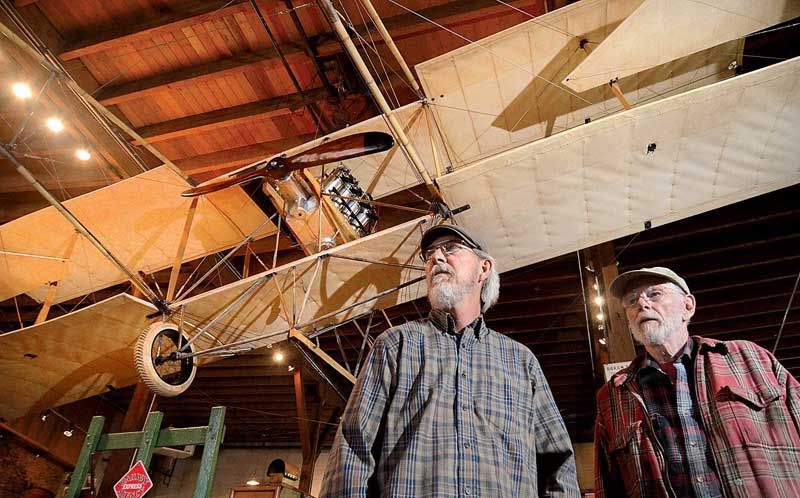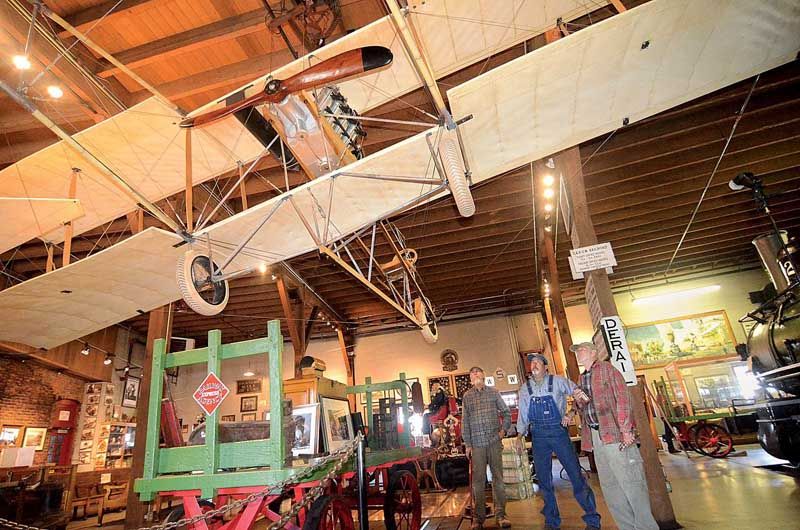Post by kiwithrottlejockey on May 7, 2013 20:44:33 GMT 12
from The Durango Herald....
The Curtiss flies again
Biplane is a replica of the first to soar over Durango
By TED HOLTEEN | 11:50PM - Monday, May 06, 2013

An unknown photographer snapped this shot of a 1913 Curtiss pusher biplane as it soared over the mesa that
is now home to Fort Lewis College during one of four of the first flights over the city of Durango in 1913.
— Photo: Courtesy of the Animas Museum.
IN September 1913, curious Durangoans gathered to witness aviation history on the mesa that decades later would be home to Fort Lewis College.
The day before, a brand-new 1913 Curtiss pusher biplane had been unloaded from a rail car. Its maiden flight would be the first plane to soar above Durango, and the flight marked a new record in high-altitude aviation for the day. That altitude probably also resulted in the plane crashing after its fourth takeoff, and the mangled wreck rolled out of town on those same rails that have always been the lifeblood of Durango.
Those rails now belong to Al Harper as the owner of the Durango & Silverton Narrow Gauge Railroad. Harper always has been a student of history, especially as it relates to his trains, and the D&SNG Museum is a testament to the impact of the railroad on Durango’s birth, growth and longevity. The town’s first car, tractor and firetruck also arrived by the railroad, and the museum has representations of each on display. So it was only natural for Harper to want a Curtiss biplane as well.
“There are only three originals left in the country, and the guy with the only one for sale wanted a million dollars for it,” Harper said. (An original 1914 version of the aircraft hangs in the Albuquerque Sunport).
Even for a man of Harper’s means, that price was out of the question. An exact replica was a more realistic goal, but his research found that even that would cost more than $75,000. It was still out of the budget, but a chance visit in the fall by local sculptor and mechanical wiz Dave Claussen changed things quickly. Locals may know of Claussen as the creator of the pinecone sculptures at the entrance to Edgemont Ranch.
“There was a rumour that Al was looking for something for the museum, and I had some ideas,” Claussen said. Harper jumped at the opportunity.
“I showed him a picture of the Curtiss, he took one look at it and said ‘I gotta build that’,” Harper said.
Claussen started researching what it would take to build a replica — lots of canvas and cables, among other things — and the men agreed on a price. Claussen rounded up a team of helpers, paid and volunteer, but because of his own travel plans and an illness, they didn’t get started until March.
“We crammed six months of work, easy, into six weeks,” Claussen said.

“We wanted it to be so authentic that people would walk in and think it was an old airplane,” said Dave Claussen, left, who
built a replica of a 1913 Curtiss pusher biplane with help from Bob Danielson and a dozen or so others. The replica hangs
in the D&SNGR Museum. — Photo: STEVE LEWIS/The Durango Herald.

Dave Claussen said although the engine on his 1913 Curtiss pusher replica is a mock-up, all the controls for the plane, including
the yoke, elevators, rudder, and ailerons, work like the real thing. Durango & Silverton Narrow Gauge Railroad Museum
curator Jeff Ellingson finishes securing the plane to the ceiling. — Photo: STEVE LEWIS/The Durango Herald.

“We crammed six months worth of work, easy, into six weeks,” said Dave Claussen, left, who built a replica of a 1913 Curtiss
pusher airplane with the help of 14 part-time workers and volunteers. Durango & Silverton Narrow Gauge Railroad Museum
Curator Jeff Ellingson, center, and Bob Danielson, who helped build the replica, look over the plane after it was
installed at the museum. — Photo: STEVE LEWIS/The Durango Herald.
The result is a remarkably authentic replica that the public got its first look at Friday during the railroad’s annual Narrow Gauge Day. The engine is a mock-up, visually accurate but not functional; a real engine would be too heavy to hang. But every other part of the plane is in authentic working order. If it had power, it could fly.
“We built it like the original except for the propeller, which is better, and three bike wheels,” Claussen said.
Claussen also substituted steel spars painted to look like the original bamboo, which tends to crack over time.
Harper said he’s more than happy with how the plane turned out, especially because Claussen finished in time for the centennial commemoration of Durango’s first airplane flight.
“My wife and I are so proud of the museum,” he said. “There’s something there for everyone, and it all ties to the railroad’s impact on the community.”
www.durangoherald.com/article/20130506/NEWS01/130509694/The-Curtiss-flies-again


